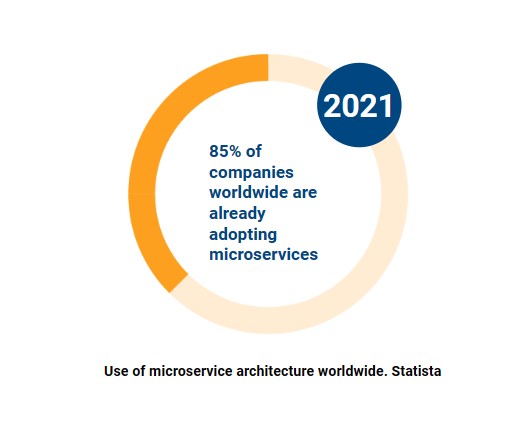
Why microservices development is the future of enterprise software development
May 16, 2023
Table of contents
Quick Access

Trends in the technological world tend to change overnight: what today is the most used by companies to create or update their systems, in a few months will be obsolete or displaced by a new trend. Currently, microservices have made their way as one of the ideal solutions for business software development.
The development of business software is a fundamental pillar of any company worldwide, it is what allows it to have a website or a mobile application where its clients and users can go when they need attention, support or look for any information related to the organization. or the products and services it provides.
The microservices solution, while not new, has risen in popularity over the past few years and can be the ideal solution for a dynamic, effective and competitive business website.
What are microservices
Considered as an architecture, microservices provide a lot of freedom to companies when working on their platforms, processes, and applications. Under this structure, the software is made up of just small services that are independent of each other, communicated by defined APIs. This allows scalability, flexibility, and agility to grow across all workflows.
“With a microservices architecture, an application is built with separate components that run each application process as a service. These services communicate through a well-defined interface using lightweight APIs”, they explained in this regard in the AWS documentation. Each service executes a single business function.
A study even showed that 63% of companies worldwide are already adopting microservices, which makes this solution a reality and paints a future where we will see much more of it.

Microservices: the future of business development
Microservices have gained significant traction in the enterprise software development industry over the past decade, and their popularity is expected to continue well into the future.
Microservices offer several benefits over monolithic architectures, including higher scalability, faster deployment, easier maintenance, and improved resiliency. They also allow organizations to take a more modular approach to development, allowing different teams to work on different services independently and enabling faster delivery of new features and updates.
One trend that is expected to shape the future of microservices development is the increasing use of container orchestration and container orchestration technologies, such as Docker and Kubernetes. These technologies provide a highly scalable and flexible infrastructure that enables organizations to deploy and manage microservices at scale more efficiently.

Another trend is the increasing adoption of serverless architectures, which allow organizations to develop and deploy applications without the need to manage servers or infrastructure. Serverless architectures are well-suited for microservices-based applications, as they provide a highly scalable and cost-effective way to implement individual services.
Overall, the future of microservice development in enterprise software development looks bright. As organizations continue to look for ways to increase agility and reduce time to market, microservices will continue to be a popular option for building scalable and flexible software applications. The use of containers, serverless architectures, and other emerging technologies will only enhance the benefits that microservices offer, allowing organizations to build more robust and resilient applications that meet the changing needs of their customers.
We recommend you on video
Related Blogs

React Native vs Ionic framework

Best practices from a native mobile app development company

Top 5 React Native online compiler

How to use React Native in VS code
How to run a React Native app

